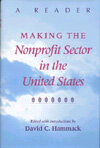Making the Nonprofit Sector in the United States
If you slept through your high school and college history classes and have no idea how John Winthrop, James Madison, and W. E. B. DuBois relate to America's nonprofit sector, you'll want to stop reading and immediately order this book. Indeed, editor David Hammack has compiled a selection of readings that every nonprofit professional, policymaker, student of the sector, and volunteer will want to have on their bookshelf.
The readings are arranged chronologically, with section one devoted to illustrating the profound effect that religious and governmental leaders in seventeenth- and eighteenth-century America had in shaping the country's nascent nonprofit sector. For instance, "A Model of Christian Charity," by John Winthrop, elaborates a concept of communal interdependence that closely resembles the impetus of many contemporary faith- and community-based organizations. "We must delight in each other, make others' conditions our own, rejoice together, mourn together, labor and suffer together," writes Winthrop, "always having before our eyes our commission and our community in the work, our community as members of the same body."
The Founding Fathers, including Benjamin Franklin, Thomas Jefferson, and James Madison, are also well represented. For encouragement, read about Benjamin Franklin as he races around pre-Revolutionary Philadelphia organizing fire brigades, coordinating city clean-ups, and raising money for hospitals — the hard and rarely praised work of civil society. Similarly, Madison's contribution, Federalist No. 10, brilliantly explicates the competitive, pluralist dynamic that, Madison argued, should exist at every level of American government and society.
Selections culled from the nineteenth and early twentieth centuries range from original essays by Daniel Webster, John Marshall, and Alexis de Tocqueville (who observed in 1834 that "In no country in the world has the principle of association been more successfully used or applied to a greater multitude of objects than in America") to important scholarly works by W. E. B. DuBois and Kathleen McCarthy, and, taken together, deepen our understanding of the enduring theme of civil society in the United States.
To capture the scope and pace of changes in the nonprofit sector from the 1920s to the present day, Hammack selects readings about a range of topics, from community chests and community foundations, to private schools and nonprofit revenues. At the same time, items such as "The Third Sector" (1974), by the Commission on Private Philanthropy and Public Needs, provide evidence for Hammack's contention that the field, in the second half of the twentieth century, became more professionalized and bureaucratized. The increased role of federal regulation and money is also covered in some depth.
While Hammack may have erred on the side of comprehensiveness in focusing on the role of the federal government, the dream of individuals such as Jane Addams, Martin Luther King, Jr., and Billy Graham — none of whom is represented here — to create a more civil society remains a potent force.
By the end, every reader of this volume will be provoked to consider the nonprofit sector from a variety of fresh perspectives while, at the same time, discovering abundant inspiration in the words of those represented here. Moreover, most readers will agree that the making of the nonprofit sector in the United States has been a highly successful endeavor, and that Hammack's compilation performs a commendable service in documenting the story of that long and still-unfolding journey.








